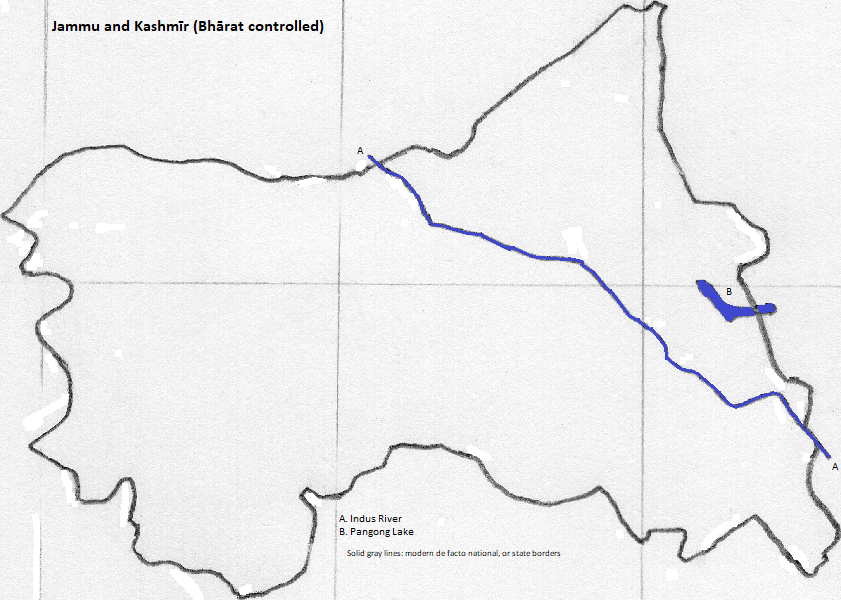
| To Duval Family Home Page | Asia |
| To Chris Home Page | भारत (Bhārat or India) |
| To Earth (Geography Home Page) |
Most of this area is high mountains--all part of the Himalayas. The Vale of Kashmīr is in the northwest, where one will find the headwaters of the Jhelum, a tributary of the Indus. South of it--beyond the Pir Panjal Range--are even lower lands: Jammu, home to the upper Chenab, another tributary of the Indus. East of Kasmīr, the war-line between India and Pakistan runs through the Pangi Range. Running northwest to southeast beyond these valleys are the Zaskars. Within them is their namesake river, yet another tributary of the Indus. The Indus itself flows through a high valley between the Zaskar and the Ladakh Ranges. On the far side of the Ladakhs, the another of the great river's tribuaries, the Shyok, flows below the farthest range: the southeast end of the Karakorams. The Pir Panjals are less than 4,000 meters, the Zaskars reach over 7,000 meters at Nunkun, and the others' heights are in between.
Tourists enjoy Pangong Lake in the Leh Ladahk region, and the scenic settings of the village of Gulmarg, the resort of Patnitop (near the village of Kūd), the town of Pahalgam, and the seasonal village of Sonamarg.

The majority, almost 11 of every 20, speak Kashmiri. The next most important language is Dogri,
The majority religion is Islam, practiced by almost seven in ten. Hindus constitute most of the remainder.
The largest city is Srīnagar, the summer capital of the state. Jammu (population 576 thousand in 2011
Tourists enjoy: the Hindu cave temple of Vaishno Devi (15 kilometers from the town of Katra); the Hindu ice lingam of Shiva found in the cave of Amarnath (reachable from the town of Pahalgam); and the Buddhist monastery at Lamayuru.
The linguistic make-up is probably ancient. For example, Kashmiri is thought to have been spoken in the Vale 3,000 years ago. The Indo-Aryans split from other Indo-Iranians in central Asia about 4,000 years ago and moved southeast through the mountains. They brought with them common Indo-Iranian religious practices like horse sacrifice. Over time, under influences from the south, Brahmanism and Buddhism evolved. Yet later, again in concordance with the south, Brahmanism evolved into Hinduism. Buddhism persisted among Indo-Aryans here longer than in most other parts of India.
northeast
east
south
west and north
1. India is the other official name (in English).
2. This article excludes India's claims in Pakistani and Chinese controlled areas.
3. I do not know the Urdu script representation of the state's name. Urdu is the state's official language, though few speak it.
4. https://www.holidify.com/state/jammu-and-kashmir/top-destinations-places-to-visit.html, accessed December 25, 2018. I selected the first ten. For Leh Ladakh (#2) I narrowed it to Pangong Lake, which was the featured picture.
5. Dogri is sometimes considered a dialect of Panjabi.
6. Gujuri is sometimes considered a Rajasthani dialect.
7. http://www.citypopulation.de/php/india-jammukashmir.php, accessed December 25, 2018.
8. https://en.wikipedia.org/wiki/List_of_the_busiest_airports_in_India, accessed December 25, 2018. I selected the two serving the state that had over a million passengers in 2017-2018.
9. Source: A Historical Atlas of South Asia, plate IV.4, "Religious and Cultural Sites, 8th - 12th centuries (1978, Univ. of Minn.).